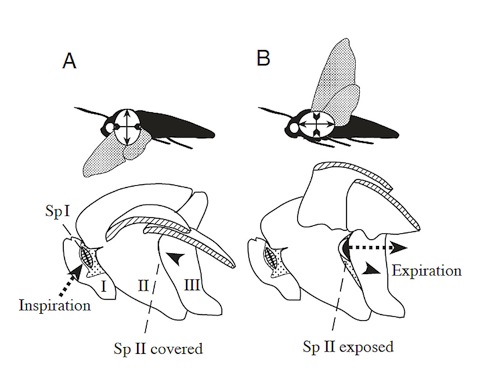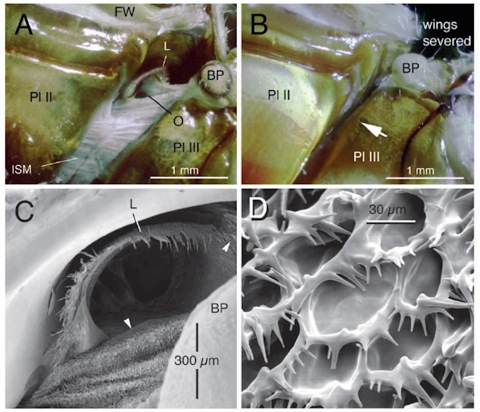Wasserthal, L.T. (2001): Flight-motor-driven respiratory air flow in the hawkmoth Manduca sexta. J. Exp. Biol. 204, 2209-2220.
Intratracheal pressure during tethered flight was analyzed at the anterior spiracles and mesoscutellar air sacs in the hawkmoth Manduca sexta using electronic pressure sensors. CO2 emission from the anterior spiracles and the posterior thoracic and abdominal spiracles was measured using a URAS gas analyzer with a split-specimen chamber. Experiments were accompanied by photocell recordings of the wingbeat. The structural differences between the mesothoracic and metathoracic spiracles are described. Deformations of the lateral thorax and their effect upon the spiracles were observed under stroboscopic light. During shivering, ventilation pulses are generated by the flight muscles reminiscent of an autoventilation mechanism with tidal air flow. During steady flight, however, a unidirectional airstream arises with a mean negative (subatmospheric) pressure at the first (mesothoracic) spiracles and a mean positive pressure in the mesoscutellar air sacs. As a result of this pressure difference during flight, CO2 is emitted only at the posterior spiracles. The suction force for the inspiration flow at the anterior spiracles is generated by the flight apparatus as a result of prevention of inspiration through the posterior thoracic spiracles. During the downstroke, the volume of the thoracic air sacs increases, while the posterior thoracic spiracles are automatically enclosed in the subalar cleft below the wing hinge and are probably closed. During the upstroke, the air sac volume decreases and the moth expires through the open posterior spiracles.

The deformation of the thorax during wingbeat is coordinated with exposition and action of the spiracle II.
During downstroke the spiracle II is closed (A), during upstroke it is exposed and opened (B).
Scanning light and electron micrographs of the spiracle II in open condition during upstroke of the wings (A, C) and in the hidden position during downstroke (B).

